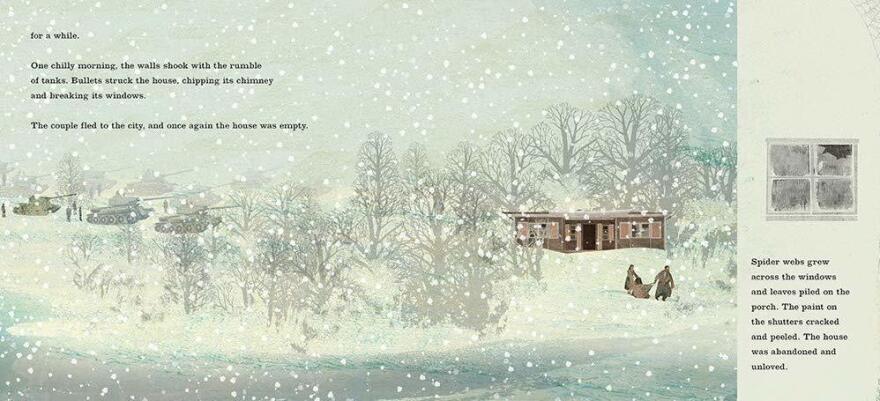A picture book about Nazi persecution, air raids and Communist secret police informants seems an unlikely children's bedtime story.
But The House by the Lake by Thomas Harding is also about belonging.
Adapted from his best-selling memoir of the same name, Harding tells the tale of a house in the forested outskirts of Berlin and the four families — who were Jews, Nazis, refugees and Communists — that lived in it from 1927 to 1999. It's the story of a house that's stood in four different Germanys: The Weimar Republic, the Third Reich, Communist East Germany and today's reunified Germany.
Following in a rich children's literary tradition of bringing inanimate objects to life, Harding makes the house his protagonist. "People come and go from the story, but the house remains," Harding tells NPR, explaining that "the house is a witness, situated on the front lines of 20th century German history." It protects as families seek refuge within it, before having to flee again. It watches as its beautiful lakeside garden is torn apart by soldiers to make way for the Berlin Wall.
Like many other buildings in and around the German capital, the house is more than a sum of its four walls. The layers of wallpaper and scratches on the floorboards are the traces of its previous occupants. As the protagonist, Harding's house literally holds memories: "The walls and the floors and the windows and the doors remembered the kind doctor and his cheery wife," he writes.
That "kind doctor and his cheery wife" were Harding's great grandparents, the Alexanders, who built the house in 1927 as a modest family weekend retreat where they could get their fill of what the Germans call Sommerfrische – a place to escape the bustle and heat of Berlin summers. Alfred Alexander was a prominent physician whose patients included Albert Einstein and Marlene Dietrich. Harding's grandmother, Elsie, spent her childhood in the house and referred to it as her "soul place." In 1936, the Gestapo seized the house, forcing the Alexanders into exile in London.
Then came the Meisels, who took advantage of the Nazi policy of Aryanization and bought the house cut-price from the Gestapo, only to flee themselves to Austria towards the end of the war. Next came the Hartmanns, seeking refuge from the bombs and fighting in Berlin until the Soviets came and occupied the village in April 1945. Then, in 1958 Wolfgang Kühne moved in with his wife and children. In 1961, Kühne — who was an informant for the East German secret police — woke up to find the Berlin Wall being built through his back yard. In 1989, he watched from the house as the Wall came down.
Illustrated by Britta Teckentrup, the house is rendered in crisp, woodcut-like lines and bright colors which contrast starkly with shadowy figures around the edges. The turbulent times are also depicted by striking contrasts. On one page, the Meisels' sons are pictured building sandcastles without a care in the world; on the next page, they're standing to attention in Hitler Youth uniforms. Teckentrup's illustrations are often more candid than Harding's text. He doesn't refer to the Gestapo by name, but calls them "angry men." Harding is equally sparing in detail about the Communist regime, describing simply how the "man in the fluffy hat" spies on his neighbors.
Harding says, initially, he was concerned the themes might be too dark for children but realized that they were relatable:
"Kids are familiar with loss, with things being taken from them. They're familiar with angry people or bullies. These are experiences children have, whether it's being forced to leave a home because of something as mundane as moving house or maybe something more difficult, like divorce or maybe as refugees."

Harding says the idea to adapt his book for children came when he saw a child touch the hole in the wall left by a Soviet bullet in 1945 — and he realized the power of material history.
Like this home, Berlin itself is full of tangible reminders of its past. Look down as you walk and you'll stumble upon brass cobble stones embossed with details of a lost life. Look up and you'll still see bullet holes and other physical reminders of the war.
Ulrike Zitzlsperger, professor of German at the University of Exeter in the UK, says Berlin was once covered in these battle scars. "Increasingly, the bullet holes are vanishing," Zitzlsperger says. 'While you can't start enshrining them, these bullet holes are a far more poignant war memorial than any of the official ones.'
As gentrification smooths over Berlin's wartime damage and the last eyewitnesses reach their 90s, Zitzlsperger says stories like that of Harding's family house become ever more important. And yet the story only came about when Harding tried to save the house which, he says, local authorities were going to bulldoze to make room for construction unless he could prove its historical and cultural value. The House by the Lake —both the adult version and this new book for children — is the result of that endeavor, and the house is now a museum.
Harding, who started writing the book in order to save his grandmother's "soul place" — the last physical trace of the Alexanders in Germany — ended up writing as much about the other families as his own, despite their differences. He has since met descendants from all the families. As a result, The House by the Lakeis a story about reconciliation, and the meaning of home.
Esme Nicholson is an NPR reporter based in Berlin.
Copyright 2021 NPR. To see more, visit https://www.npr.org. 9(MDAxODc0NzU5MDEyMTgyMDUxMzlkN2IzMw004))


